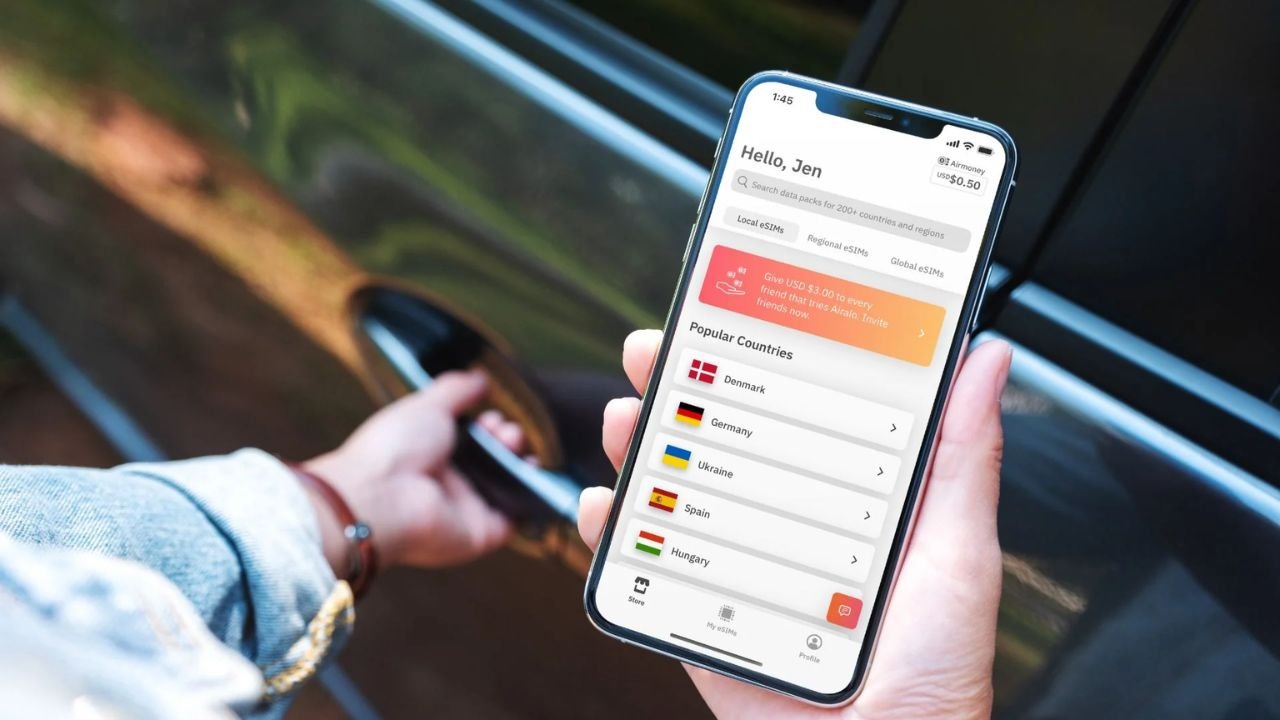In a world where connectivity has become as essential as running water, finding the best way to stay connected while traveling isn’t just convenient, it’s necessary. Traditional SIM cards are quickly becoming relics of the past as digital alternatives take center stage.
According to recent research, the travel eSIM retail market is projected to grow by an astounding 500% between 2023 and 2028 as both leisure and business travelers embrace more affordable connectivity options. This shift isn’t surprising given the hassles of physical SIMs and expensive roaming charges that have plagued travelers for years.
Let’s explore why eSIM technology’s advantages are transforming how we stay connected and why they’ll be your best companion for global adventures in 2025.
Understanding eSIM Technology: The Digital Revolution
The way we connect to mobile networks is changing dramatically with embedded SIM technology leading the charge. Before diving into specific benefits, it’s worth understanding what makes this technology so revolutionary.
eSIM technology represents a fundamental shift from physical to digital. Unlike traditional SIM cards that you physically insert into your device, an eSIM is built directly into your phone’s hardware. This tiny chip can store multiple network profiles simultaneously, allowing you to switch carriers without swapping physical cards.
China has become one of the leading adopters of this technology in recent years. The country’s vast geography and massive population have made it an ideal testing ground for advanced connectivity solutions.
When traveling to this tech-forward nation, having an esim for china simplifies the entire process of staying connected. Instead of dealing with language barriers at local shops or trying to decipher Chinese carrier plans, you can set up your connection before you even land.
Beyond eSIM: The Emergence of iSIM and What It Means
While eSIM technology advantages continue to grow, the industry is already looking ahead to the next innovation: integrated SIM (iSIM). This technology takes miniaturization to a new level by incorporating SIM functionality directly into a device’s processor.
The main difference between eSIM and iSIM lies in integration depth. eSIMs still require a dedicated chip on your device’s motherboard, while iSIMs become part of the processor itself. By 2025, we’ll likely see both technologies coexisting, with iSIMs appearing in smaller IoT devices where space is at a premium.
7 Game-Changing eSIM Benefits for Global Travelers in 2025
The advantages of eSIM extend far beyond convenience, offering solutions to most traditional connectivity problems. These benefits highlight why eSIM is truly the best mobile connectivity option for 2025 travelers.
1. Instant Activation Anywhere in the World
One of the most powerful eSIM benefits is the ability to activate service instantly, no matter where you are. Forget hunting for a local mobile shop after a long flight or waiting in line at an airport kiosk.
With eSIM, you can scan a QR code and have your connection running in minutes. By 2025, this process will become even more streamlined, with some providers offering activation through a simple app click or even voice command. Travelers can already experience this convenience with options like eSIM Japan, which allows instant connectivity without the hassle of physical SIM cards.
2. Ultimate Flexibility with Multi-Profile Management
Traditional SIMs limit you to one carrier at a time. eSIMs, however, can store multiple profiles simultaneously, allowing you to stay connected 2025 and beyond with unprecedented flexibility.
This means you can keep your home number active while also using a local data plan abroad.
Business travelers can maintain separate work and personal profiles on a single device. You might use one profile for high-speed data and another for cheaper calls, all without swapping physical cards.
3. Enhanced Security Protocols
Security concerns often plague travelers, but eSIM technology provides robust protection against common risks. Unlike physical SIMs that can be stolen or swapped, eSIMs are embedded within your device and protected by multiple authentication layers.
By 2025, eSIM comparison with traditional options will show even greater security advantages as biometric integration becomes standard. Your fingerprint or facial recognition might become required to switch between eSIM profiles, adding another layer of protection.
4. Cost Savings with Local and Global Plans
One major draw of eSIMs is the potential to save money. With a traditional SIM, travelers often face high roaming fees or waste time comparing local carriers after arrival. eSIMs change that: you can compare and purchase the best local or regional data plans before you even land.
Many eSIM providers offer competitive short-term and long-term travel packages. By 2025, expect even more bundled deals and real-time price comparisons through your phone, helping you cut down your mobile expenses effortlessly.
5. Seamless Switching Between Networks
Unreliable coverage is a constant worry when exploring new destinations. eSIM makes poor reception a thing of the past. With multiple profiles at your fingertips, you can switch to the strongest local network in seconds, no more dropped calls or painfully slow data.
This capability is especially valuable for digital nomads, remote workers, and adventure travelers who move between cities, regions, or countries in a single trip.
6. Reduced Environmental Impact
As sustainability becomes a bigger priority in 2025, eSIMs stand out for reducing plastic waste and packaging associated with physical SIM cards.
By going digital, millions of tiny plastic cards and paper inserts are eliminated, along with the carbon footprint tied to shipping them worldwide. Choosing an eSIM means your travel habits align better with eco-friendly goals, a win for both you and the planet.
7. Better Device Compatibility and Future-Proofing
Smartphones, tablets, laptops, and even smartwatches increasingly come with built-in eSIM support. By 2025, most new devices will prioritize eSIM as the standard, giving travelers a future-proof solution that works across all their gadgets.
This means no need to hunt for special SIM card sizes or carry extra adapters. Just load your preferred data plan on any supported device and stay connected on the go.
Global Connectivity Without Borders: eSIM Around the World
The true power of eSIM becomes apparent when traveling across multiple countries. Traditional connectivity methods force you to juggle multiple physical cards or accept exorbitant roaming charges.
Unrestricted Access in Censorship-Heavy Regions
When traveling to countries with internet restrictions, maintaining your digital freedom becomes challenging. Many travelers find themselves unable to access favorite apps and websites due to government firewalls.
Quality eSIM providers offer built-in solutions for these challenges, providing unrestricted internet access even in countries with heavy censorship. This isn’t just convenient, it’s essential for business travelers who need access to tools like Gmail or Slack.
Regional eSIM Coverage Comparison
Coverage quality varies significantly between regions, with some areas offering blazing 5G speeds while others still building out their networks. By 2025, best mobile connectivity will be determined largely by how well providers have expanded their coverage maps.
North America and Western Europe currently lead in eSIM adoption, but Asia-Pacific regions are rapidly catching up. Emerging markets in Africa and South America are expected to see dramatic improvements by 2025, making global connectivity more uniform.
The Future of Mobile Connectivity is Here
The shift toward eSIM represents more than just a technological upgrade, it’s a fundamental reimagining of how we connect globally. As we move toward 2025, the advantages of this technology will only become more pronounced, with improved security, greater flexibility, and seamless integration across devices.
Whether you’re a business traveler hopping between continents or a digital nomad seeking reliable connectivity, eSIM technology offers the freedom and reliability that physical SIMs simply cannot match. The future of staying connected has arrived, and it fits inside your device with room to spare.
Common Questions About eSIM Technology
What happens if I lose my phone with an eSIM?
Unlike physical SIMs that can be removed and inserted into a new phone, eSIMs require digital transfer. Most providers now offer simple profile backup and restoration processes, making it easy to migrate your eSIM to a replacement device.
Do eSIMs work with all mobile carriers?
While most major carriers worldwide now support eSIM technology, smaller regional providers may still be catching up. By 2025, expect near-universal support as the technology becomes standardized across the industry.
Will eSIMs eventually replace physical SIM cards entirely?
All signs point to yes. Many flagship phones already offer eSIM-only models, and by 2025, physical SIM slots may become as rare as headphone jacks are today. The transition is happening faster than many expected.



